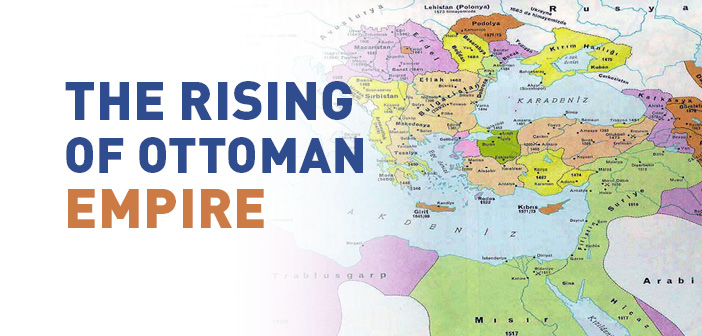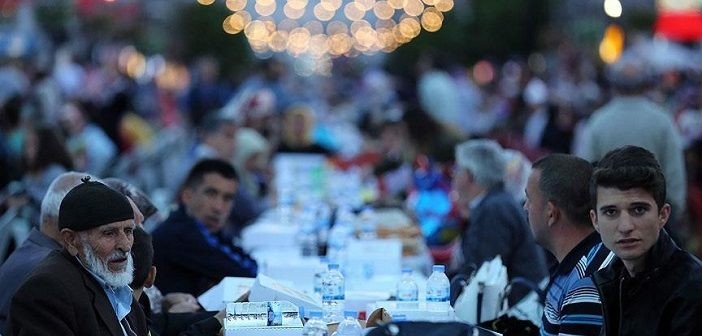
The Rising of Ottoman Empire
What started the rise of the Ottoman Empire? What happened during the rise of the Ottoman Empire? What was the rise and fall of the Ottoman Empire?
This period which began with the conquest of Istanbul and lasted until the death of Sultan Süleyman I is the period of the rise of the Ottoman State. The important sultans of this period were Mehmed II (1451–1481), Bayezid II (1481–1512), Selim I (1512 – 1520) and Sultan Süleyman I (Kanuni) (1520 – 1566).
The Major Incidents That Took Place in the Period of Rising:
1. The Conquest of Istanbul (1453)
When Sultan Mehmed II ascended to the throne, his aim was to establish a universal state. The first thing to achieve this aim was to conquer Istanbul. There were many reasons behind the young sultan’s desire to capture Istanbul: Byzantine was sometimes causing problems to the Ottomans who wanted to transfer troops from Anatolia to Rumelia or from Rumelia to Anatolia. Whenever it got a chance, it provoked the European states and Anatolian principalities against the Ottomans. It helped şehzades or the sultans’ sons in their uprisings and thus caused civil wars in the state.
The facts that Istanbul was an important cultural center and that it was on the routes of land and sea trade made it geographically a very important place.
The conquest of Istanbul was also important for religious reasons. Every Muslim commander wanted to be the conqueror praised in the narration in the Prophet Muhammad’s (pbuh) saying, “Constantinople will surely be conquered. What a blessed commander is the one who conquer it and what a blessed army is the one that conquer it.” This was why the city was besieged and tried to be conquered many times by the Muslims. During the periods of Umayyads and Abbasids, it was besieged eight times and during the Ottoman period, it was besieged three times, but it could not be conquered.
II When Sultan Mehmed II was making preparations for the conquest of Istanbul, the Byzantines increased their defensive precautions. They had the damaged city walls and fortresses restored. They had the entrance of the Golden Horn closed with a chain. They asked help from the Christian countries. In order to get the assistance of Christian world, they tried to unite the Catholic and Orthodox churches and a big ceremony in Hagia Sophia was organized for this purpose. However, the Orthodox people of Byzantine reacted this. The Grand Duke of Byzantine Loukas Notaras’s words: “I prefer seeing the Ottomans’ turban to seeing the cardinal’s cap in Constantinople” show that the efforts of uniting the Christian sects were in vain and the people of Istanbul would prefer Ottoman justice.
Sultan Mehmet II made important preparations for the conquest of Istanbul:
To be able to take the Bosporus under control, Sultan Mehmet II had the Rumelian Castle built. To be able to take the Bosporus under control, Sultan Mehmet II had the Rumelian Castle built. In order to pass the famous Byzantine walls which had been the most effective reason for the failure of the previous sieges, he had huge cannons molded in Edirne. He also established a strong navy to use it for the attacks from the sea.
After completing his preparations, Sultan Mehmed II besieged Istanbul on April 6, 1453. An envoy was sent to the Emperor of Byzantine and he was asked to surrender the city without resisting. However, when this offer was rejected, the attack started by cannon fires. More than seventy ships were slid over sledges through the land and landed to the Golden Horn in one night.
Sultan Mehmed II, who offered to the Emperor to surrender one last time, started a big attack upon refusal of his offer and Istanbul was conquered on May 29, 1453.
After the conquest, the young sultan entered the city with a procession. He became the “Conqueror.” He came to Hagia Sophia church, which had a very important place in the history of Byzantine and Christianity. To thousands of Christians who gathered in the Church and were waiting in fear, the Sultan said that their religious and sectarian freedom was under protection, their properties were not going to be looted, and those who had fled the city could come back.
Sultan Mehmed II kept his promise and did not touch the Orthodox Church in Istanbul. He turned Istanbul into a Muslim city through developmental activities. He had many Turks brought from Anatolia settled in the city.
The results of the conquests of Istanbul have a very important place in the Ottoman and world history. The Byzantine Empire was collapsed. This incident was received in the Muslim world by great joy. Istanbul started to become a center of knowledge and civilization. Many scholars of the Orient and the Occident came to Istanbul and began to produce works under the protection of Sultan Mehmed II that enlightened the world. Thanks to the conquest, the control of the important trade routes were brought under control of Turks.
The collapse of Byzantine caused great sadness in Europe, for it also led to the collapse of the hopes of the Christian World to reach Jerusalem over Byzantine. It meant the loss of an important base. The new cannon molding techniques developed by Sultan Mehmed II for the siege of Istanbul proved that the city walls were not indestructible any more. This development led to the collapse of European feudalism and emergence of central and powerful states.
2.The Developments in the Balkans
The conquest of Istanbul by Turks received reactions in Europe. Balkan communities were in fact pleased from the tolerant policies of the Turks. However, the Pope, kings, and feudal lords did not share the same views. They did not give up their desires to wipe the Turks out of the Balkans. The conquest of Istanbul rekindled those desires. The Pope called the European states to gather again under the flag of Crusades. Sultan Mehmed II who was monitoring the developments closely took action without giving the Crusades a chance to pull themselves together.
He ruined their Crusaders’ plans by capturing Serbia in 1459, the Morea in 1460, Moldavia and Wallachia in 1476. The Ottoman authority in the Balkans reached down to the Adriatic Sea. The ruler of Bosnia not only was refusing to pay his tribute but also following a policy siding the Hungarians. In 1463, Ottoman forces moved over Bosnia and Herzegovina. Because Bosnians had been tired of Catholic pressure and heard about the Ottoman’s utmost respect to religious and sectarian freedom, they surrendered without showing any resistance. People’s love for the Muslims Turks was so strong that all of the men who could use weapons joined the army. After a while, all Bosnians embraced Islam. In the following centuries, they joined among the Ottoman military and administrative officers and gave great services for the state.
3. The Developments in Anatolia and the Seas
While Ottomans were continuing their conquest movements to the West in order to deliver the message of Islam to Europe, some Turkish principalities in Anatolia conspired with the enemy and tried to attack the Ottomans behind. The most significant of those principalities were İsfendiyar Beyliği in Sinop, Karamanoğulları in Middle Anatolia and Akkoyunlu State in the East. After the conquest of Istanbul, military expeditions were organized in order to eliminate those principalities that caused continuous troubles for the Ottomans and to achieve unity in Anatolia. In 1460 İsfendiyar Beyliği, in 1473 Karamanoğulları Beyliği and in 1487 Akkoyunlu State were eliminated and the order in Anatolia was established.
After the conquest of Istanbul, sea expeditions were organized in order to ensure the safety of Bosporus and the Dardanelles straits and their coasts. Many islands in the Aegean Sea were captured and thus the precautions were taken against the dangers which were possible to come from the sea.
Ottomans who took Anatolia under their authority became neighbors with Safavid Dynasty which was founded by Shah Ismail in the East based on Shiite principles (1502). The object of Shah Ismail was to spread Shiite understanding in Iran and Azerbaijan, which he had already taken under control, and then to take Anatolia from the Ottomans. In order to reach this goal, he had Shiite propaganda made in Anatolia and caused disorder in Ottoman Empire. Upon this Sultan Mehmed II’s grandson Sultan Selim I organized a military expedition over Iran. In the battle fought in the plain of Chaldiran in 1514, Shah Ismail was defeated. With the victory of Chaldiran, the Shiite danger in Anatolia was eliminated and the East borders of Ottoman State were secured.
4. The Campaign to Egypt and the Transfer of the Caliphate to the Ottomans
Caliphate which began with Abu Bakr (r.a.) after the death of the Prophet Muhammad (pbuh) and had a great religious and political significance for the Muslim world was in the hands of Turkish Mamluks who had established a state in Egypt. Mamluks ruled over a region which extended over today’s Egypt and Syria. The holy cities like Mecca, and Medina were under the authority of Mamluks. With the advantage provided by both the holy places and the caliphate, they had a saying in the Muslim world. Mamluks not only were interfering with the internal affairs of Ottoman Empire but also were in alliance with the Shiites against Ottoman Empire. With the conquest of Egypt, the Spice Road was going to be taken under control and in this way the harms given by Portuguese sailors to Muslims in Indian Ocean were going to be prevented. Sultan Selim I thought that the political power in the Muslim world should be united in one hand. After eliminating the Shiite danger, Sultan Selim I decided to move over Mamluks. He first asked the scholars’ views about how to treat the Mamluk ruler who also was a Muslim. Scholars said that it was permissible to go to an expedition. In the expedition made after getting this permission, first Mamluks were defeated in the Battle done in the plain of Marji Dabiq located near Aleppo. Syria, Lebanon, and Palestine were annexed to the Ottoman lands and thus the path to Egypt opened to the Ottomans.
Sultan Selim I sent an envoy to Mamluk Ruler Tuman Bay II and requested him to recognize his authority. Tuman Bay II not only refused this request but also had the Ottoman envoy killed. The Sultan decided that a victory without taking Egypt would be meaningless. As a result of the battle of Ridaniya fought between the two armies, Egypt was taken by the Ottomans (1517). Tuman Bay II was captured and executed. The Sherif of Mecca gave the keys of Mecca and Medina to Sultan Selim I. In this way, he gained the title of Khadim al-Haramain (the Servant of two Harams). This victory produced some important results which can be listed as follows:
- The caliphate was transferred to the Ottomans (1517).
- The Mamluk State ended and the Holy cities like Mecca and Medina were passed to the authority of the Ottoman administration.
- The Spice Road which extended from India to Mediterranean ports through the routes of land and sea were taken under the control of the Ottomans.
- Ottoman Empire became the greatest power in the Muslim world.
- Holy Relics were brought to Istanbul and placed in Topkapı Palace. These relics are still maintained in this palace.
Developments that Took Place during the Period of Sultan Süleyman I Sultan Selim I made Ottoman Empire the most powerful state of Europe and Muslim geography and left his son a full treasury. Sultan Süleyman I known by the nickname Kanuni (lawmaker) combined this opportunity with his unique leadership abilities and his era of sultanate became the strongest period of Ottoman Empire from political and military aspects both in the East and in the West. Europeans called him Suleiman the Magnificent and the Turks called him Kanuni (lawmaker) because of the laws he enacted. He is the Ottoman Sultan who ruled the longest time in the Ottoman history (46 years). He represents the peak of Ottoman might.
-
Developments in the West
At the time when Kanuni ascended to the throne, the greatest danger for Ottoman Empire in the West was Roman Germen Empire that controlled biggest part of Europe at the time and its emperor Charles V. Hungary which was supported by the emperor Charles V was planning to organize a Crusade against the Ottomans. When they killed Ottoman envoy, Kanuni organized a campaign over them and captured Belgrade (1521). Upon this incident, the relationship with Hungary worsened. Meanwhile, Francis I the King of France was taken as captive by the king of Hungary. His mother was forced to ask help from Kanuni who was a Muslim ruler instead of the Christian king in order to save her son from captivity. Taking the support of France by his side, Kanuni organized another expedition to Kingdom of Hungary in order to break up European Christian unity. The Battle of Mohac which lasted very short resulted with a certain victory of Ottoman army (1522). Francis I was saved from captivity and the problem of Hungary was solved.
From that time on, Ottoman-French relations got strengthened. In 1535 upon Francis I’s request, an agreement called ahitname by the Ottomans and capitulations by the French was signed between the two states. In this way, Kanuni managed to separate France from the alliance of the Crusaders. With this agreement, French and Ottoman merchants gained many mutual rights. However, the rights given to the French eventually led to results against Ottoman Empire and prepared the ground for its economy to be depended on outside sources and for the collapse of the state.
Kanuni went on another military expedition when Ferdinand the King of Hungary occupied Budin which was under Ottoman ruling. After he retook Budin, he besieged Vienna which was like the gate of Europe (1529). His aim was not to take Vienna but to force Ferdinand to battle. This was why he had not made enough preparations. Because winter was approaching, the siege was lifted. The first siege of Vienna is important not only because the Europeans felt the Turkish threat closely but also show the level that the power of Ottomans reached.
-
The Developments in the Seas
Aegean Sea and the Mediterranean: After the 16th century as a result geographical expeditions, the strength of Europe started to increase. Kanuni who wanted to control and revive the trade in the Mediterranean and Indian Ocean paid attention to navy. Important struggles were given in the seas against European states. Many islands in the Aegean sea were captured. African lands along the coast of the Mediterranean were also taken under control. The successes of the Ottomans led the establishment of the Crusaders’ navy. In the Battle of Preveza which took place between Ottomans and the Crusader forces, Ottoman forces won a clear victory (1538). With this victory, the superiority in the Mediterranean was completely taken by the Turks.
After the conquest of Egypt, Cyprus, which is the biggest island on the East of the Mediterranean, was taken from the Genoese (1571). Upon Turkish dominance over the East Mediterranean, Europeans established a big navy and defeated the Ottomans in the Battle of Lepanto. However, this defeat did not weaken the strength of the Ottomans. A new navy was established in a short time. During the same dates, opening the Suez Canal was designed but it could not be completed because of lack of necessary attention
Indian Ocean: Europeans whose commercial interests were damaged upon transfer of the control of East-West trade routes to the Turks started to look for new trade routes. This was one of the reasons of the geographical expeditions. The Portuguese who passed around the Cape of Good Hope and reached India started to control the trade in that region and become an obstacle for the Muslim merchants’ trade in the Indian Ocean. Ottomans organized expeditions to change the situation in favor of their own interests (1538 – 1553). Because of the reasons such as the strong navies of the Portuguese, not getting support of the Muslim rulers of the region, and Ottomans’ giving priority to the dominance of the Mediterranean and the West, those expeditions did not produce the expected results. At the end of those expeditions, Yemen, Eritrea, Sudan coasts and part of Ethiopia were annexed to the Ottoman lands.











